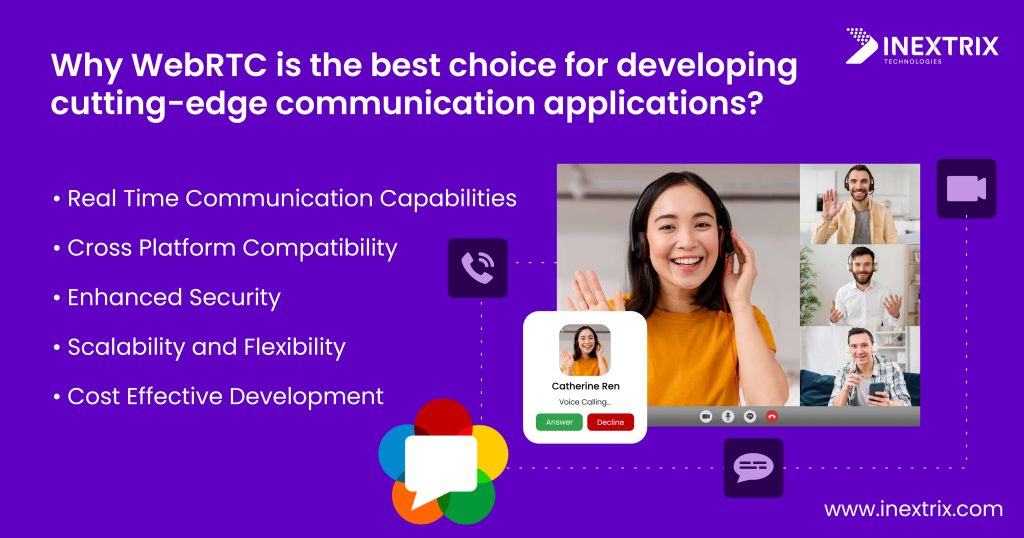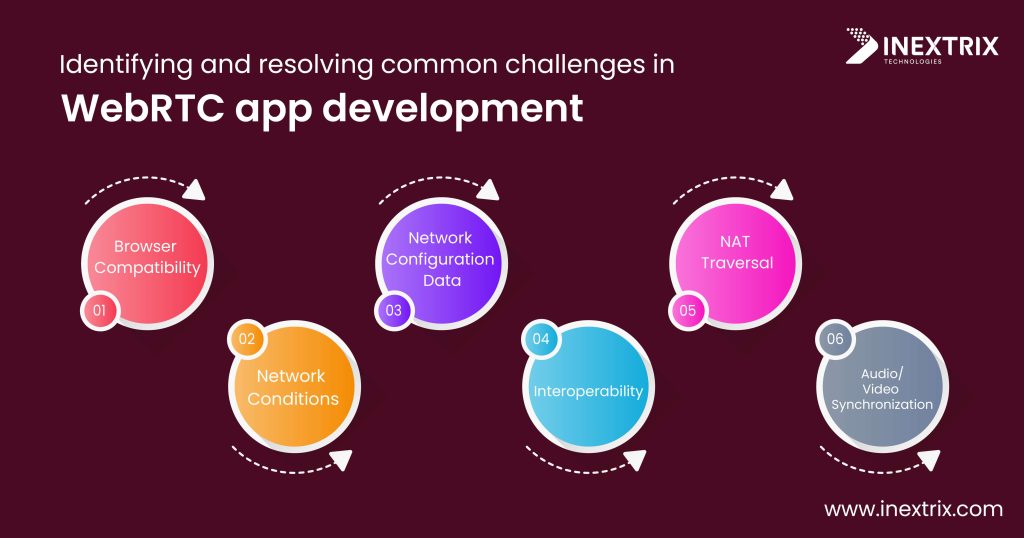Certainly, the way we communicate has undergone significant transformations over the past few decades. From traditional landline telephones to the rise of mobile communication, each advancement has brought us closer to seamless, real time interaction. Today, the demand for real time communication apps is booming, driven by the need for instant connectivity in our personal and professional lives. WebRTC app development is at the forefront of this shift, offering unparalleled opportunities for creating robust, interactive communication platforms.
Introduction to WebRTC
WebRTC is a full form of Web Real Time Communication. Originally, it is an open source project that enables web applications and websites to capture, and optionally broadcast, audio and/or video media. Moreover, it also allows the exchange of any type of data between browsers without requiring an intermediary. This technology provides the foundation for the next generation of communication apps, which makes it a crucial component for developers. WebRTC development solutions leverages this powerful technology to create real time communication solutions that meet the growing demand for instant connectivity.
WebRTC facilitates real time communication directly between browsers without needing plugins or additional software. Key features include peer-to-peer communication, low latency, and high-quality media streams. This makes WebRTC ideal for various applications, from video conferencing to live streaming, online gaming, customer support, and telehealth services. By leveraging WebRTC, developers can create robust, interactive communication platforms that offer seamless, high-quality user experiences across different devices and network conditions.
You must read our blog post covering the influence of WebRTC and AI on the telecommunication industry. It covers detailed view over combining AI and WebRTC and major use cases that can be built with these two powerful technologies.
How WebRTC Works?
WebRTC’s architecture is designed to handle direct communication between browsers. It involves several components:
- STUN (Session Traversal Utilities for NAT): Helps in discovering the public IP address and port.
- TURN (Traversal Using Relays around NAT): Ensures data can be transmitted when direct peer-to-peer communication is not possible.
- Signaling Server: Manages the exchange of connection information between peers.
WebRTC Protocols
WebRTC uses several protocols to enable communication:
- RTCDataChannel: Facilitates real time data exchange between peers.
- RTCPeerConnection: Manages the entire connection, including the setup and management of the peer-to-peer connection.
- getUserMedia: Captures media from local devices like cameras and microphones.
Need to Build a Next Generation Communication App Using WebRTC

Certainly, building a next generation communication app using WebRTC is essential for several compelling reasons. Here are the top five detailed reasons why WebRTC is the optimal choice for developing cutting edge communication applications:
1. Real Time Communication Capabilities
WebRTC app development excels in providing real time communication capabilities. This technology allows developers to create applications that facilitate instant audio, video, and data sharing between users. The peer-to-peer architecture ensures low latency and high- quality media streams. As a result, it makes WebRTC development solutions are ideal for applications requiring real time interaction, such as video conferencing, live streaming, and online gaming.
With WebRTC application development services, users can experience smooth and uninterrupted communication. Undoubtedly, it is crucial for maintaining the effectiveness and reliability of real time applications. The technology’s ability to handle high-quality media streams ensures that users enjoy clear audio and video, enhancing overall user satisfaction.
2. Cross Platform Compatibility
It is inherently cross platform, supporting all major web browsers, including Chrome, Firefox, Safari, and Edge. Moreover, it ensures that applications built with WebRTC app development can run seamlessly on various devices, including desktops, laptops, smartphones, and tablets. Additionally, the ability to reach users across different platforms without requiring additional plugins or software installations significantly enhances user experience and accessibility.
Developers can leverage WebRTC application development services to create versatile and inclusive communication solutions that cater to a diverse user base. Furthermore, this cross platform compatibility ensures that users have consistent and high quality experiences regardless of the device or browser they are using.
3. Enhanced Security
Undoubtedly, security is a critical aspect of modern communication apps. Therefore, WebRTC development solutions addresses this need effectively. WebRTC application development services use Datagram Transport Layer Security (DTLS) for data channels and Secure Real time Transport Protocol (SRTP) for media streams. Undoubtedly, these protocols ensure that data transmitted between peers is encrypted and secure, protecting users’ privacy and sensitive information from potential threats.
Develop next-gen communication platforms with our WebRTC application development.
Certainly, implementing WebRTC development solutions allows developers to build applications that prioritize user security, offering robust protection against eavesdropping and data breaches. By incorporating these security measures, WebRTC App Development creates a trustworthy communication environment, essential for applications dealing with confidential and personal data.
4. Scalability and Flexibility
WebRTC app development offers scalability and flexibility, allowing developers to build applications that can handle a growing number of users and varying network conditions. In addition to that, techniques such as using media servers (e.g., Kurento, Jitsi) and TURN servers for NAT traversal enable applications to support multiple participants and maintain performance. Certainly, this scalability makes This development is suitable for both small scale applications and large enterprise solutions.
WebRTC application development services ensure that your app can scale efficiently, providing consistent performance even as user demand increases. Moreover, the flexibility of WebRTC development solutions means that your application can adapt to different use cases, from small group chats to large-scale webinars and conferences.
5. Cost Effective Development
Developing communication apps using WebRTC application development services is cost effective. Being an open source technology, WebRTC development eliminates the need for expensive licenses or proprietary software. Additionally, the wide range of available libraries and frameworks (e.g., SimpleWebRTC, PeerJS) accelerates development time, reducing overall costs.
Unquestionably, the community support and extensive documentation further assist developers in troubleshooting and optimizing their applications. Moreover, WebRTC application development services help businesses to create high quality communication solutions such as a web phone for a multi tenant IP PBX solution integration without incurring significant expenses. Moreover, the cost savings in app development using WebRTC can be redirected towards other critical areas. For example, it can help saving money on marketing, user acquisition, and additional feature development.
Challenges in WebRTC App Development

Certainly, this technology development is an efficient solution for peer-to-peer communication. However, there are several challenges, which can arise during implementation. Undoubtedly, understanding these potential issues will prepare you to address them effectively, ensuring a smoother development process.
By understanding and preparing for these challenges, developers can enhance the reliability and performance of their WebRTC applications. Certainly, addressing browser compatibility, managing network conditions, handling network configuration data, ensuring interoperability, tackling NAT traversal, and maintaining audio/video synchronization are crucial steps in building robust, high quality communication apps using WebRTC development.
Browser Compatibility
WebRTC app development is supported by various browsers, but the degree of implementation varies. While browsers like Chrome and Firefox offer extensive support, others may have limited or inconsistent implementation. Certainly, this inconsistency can lead to compatibility issues, affecting the user experience. Moreover, to mitigate this, developers should conduct thorough testing across multiple browsers and consider fallback mechanisms for unsupported features.
Network Conditions
Although WebRTC development solutions are adaptable, it relies heavily on real time data transmission. Fluctuations in network conditions, such as bandwidth variations or latency spikes, can impact the quality of calls. Moreover, developers must implement strategies like adaptive bitrate streaming and error correction to maintain call quality under varying network conditions. Monitoring tools and performance analytics can also help in identifying and resolving network-related issues promptly.
Network Configuration Data
Accurate transmission and reception of network configuration data are critical in WebRTC application development services. Certainly, mismanagement of this data can lead to connection failures or degraded performance. Proper handling and management of network configuration data are essential to ensure reliable peer-to-peer connections. Furthermore, developers should utilize robust signaling servers and follow best practices for data transmission to address this challenge.
Interoperability
Integrating WebRTC into existing communication infrastructures can be complex. WebRTC app development may require modifications to existing systems and technologies to ensure seamless integration. Unquestionably, developers need to plan for potential interoperability issues and design their applications to work harmoniously with other communication tools and platforms. This might involve using APIs, SDKs, or middleware to bridge compatibility gaps.
NAT Traversal
Network Address Translators (NATs) are common in many network configurations and can hinder direct communication between devices. WebRTC application development services must address NAT traversal issues to enable seamless peer-to-peer connections. Certainly, implementing solutions such as STUN (Session Traversal Utilities for NAT) and TURN (Traversal Using Relays around NAT) servers can help overcome these obstacles by facilitating the exchange of connection information and relaying media streams when direct communication is not possible.
Audio/Video Synchronization
Ensuring that audio and video streams are synchronized is an ongoing challenge in WebRTC app development. Desynchronized streams can lead to a poor user experience, particularly in applications where timing is critical, such as video conferencing or live streaming. Furthermore, developers should implement synchronization mechanisms and regularly test their applications to ensure that audio and video remain in sync under various conditions.
How to Ensure Scalability of Apps Built with WebRTC Development Solutions?
To ensure scalability in WebRTC apps, consider using media servers like Kurento or Jitsi to handle multiple participants. Implement TURN servers for reliable NAT traversal and load balancing techniques to distribute the load across multiple servers. Also, monitor the application’s performance and user load to make necessary adjustments for optimal scalability. Using cloud services can also provide the flexibility to scale resources up or down based on demand.
Frequently Asked Questions
1. How do I handle fluctuations in network conditions during WebRTC App Development?
Handling fluctuations in network conditions is essential for maintaining call quality in development. Strategies include adaptive bitrate streaming, which adjusts the media stream’s bitrate based on current network conditions, and error correction techniques to compensate for packet loss. Bandwidth management helps optimize performance under varying conditions. Monitoring tools and performance analytics can identify and resolve network-related issues promptly, ensuring a smooth user experience even with fluctuating network conditions.
2. How can I ensure audio and video synchronization in my WebRTC application?
Ensuring audio and video synchronization is critical for a good user experience in WebRTC app development. To achieve this:
- Synchronization Mechanisms: Implement synchronization mechanisms to align audio and video streams.
- Regular Testing: Conduct regular testing under various conditions to ensure that synchronization is maintained.
- Latency Management: Manage latency to reduce delays that can cause desynchronization.
- Buffering Techniques: Use buffering techniques to smooth out any discrepancies between audio and video streams.
3. What are the cost benefits of using WebRTC for app development?
WebRTC development solutions offer several cost benefits. As an open source technology, it eliminates the need for expensive licenses or proprietary software. The availability of libraries and frameworks, such as SimpleWebRTC and PeerJS, accelerates development time, reducing overall costs.
Extensive community support and documentation assist developers in troubleshooting and optimizing applications without incurring additional expenses. By leveraging WebRTC application development services, businesses can create high-quality communication solutions cost-effectively, allowing them to allocate resources to other critical areas like marketing and feature development.
4. What is NAT traversal, and why is it important in WebRTC App Development?
NAT traversal is the process of establishing peer-to-peer connections between devices behind different Network Address Translators (NATs). It is important in WebRTC App Development because NATs can prevent direct communication between devices. To address NAT traversal:
- STUN Servers: Use STUN servers to help peers discover their public IP addresses and ports.
- TURN Servers: Implement TURN servers to relay media streams when direct peer-to-peer communication is not possible.
- ICE Framework: Utilize the Interactive Connectivity Establishment (ICE) framework to manage the connection process and choose the best path for data transmission.
5. What Tools and libraries are recommended for WebRTC development?
Several tools and libraries can enhance the efficiency of WebRTC App Development:
- SimpleWebRTC and PeerJS: These libraries simplify the process of building WebRTC applications by providing easy-to-use APIs.
- Socket.io: This library can be used for real time, bidirectional communication between web clients and servers, making it suitable for signaling in WebRTC.
- Kurento and Jitsi: These media servers support complex use cases like multi-party conferencing, recording, and broadcasting.
- WebRTC Internals: A built-in Chrome tool that helps debug and monitor WebRTC applications.
Conclusion
In summary, WebRTC application development services and WebRTC development solutions provide the tools and frameworks needed to create innovative communication apps. By understanding the fundamentals, setting up a robust development environment, and leveraging advanced features, developers can build the next generation of communication platforms. Therefore, embrace WebRTC and begin your journey in building powerful, real time communication applications.
You can start leveraging the power of WebRTC by creating seamless, high quality real time communication solutions. Embrace the future of communication with WebRTC application development services offered by experts. To initiate the discussion of your WebRTC app development project, please contact us.



